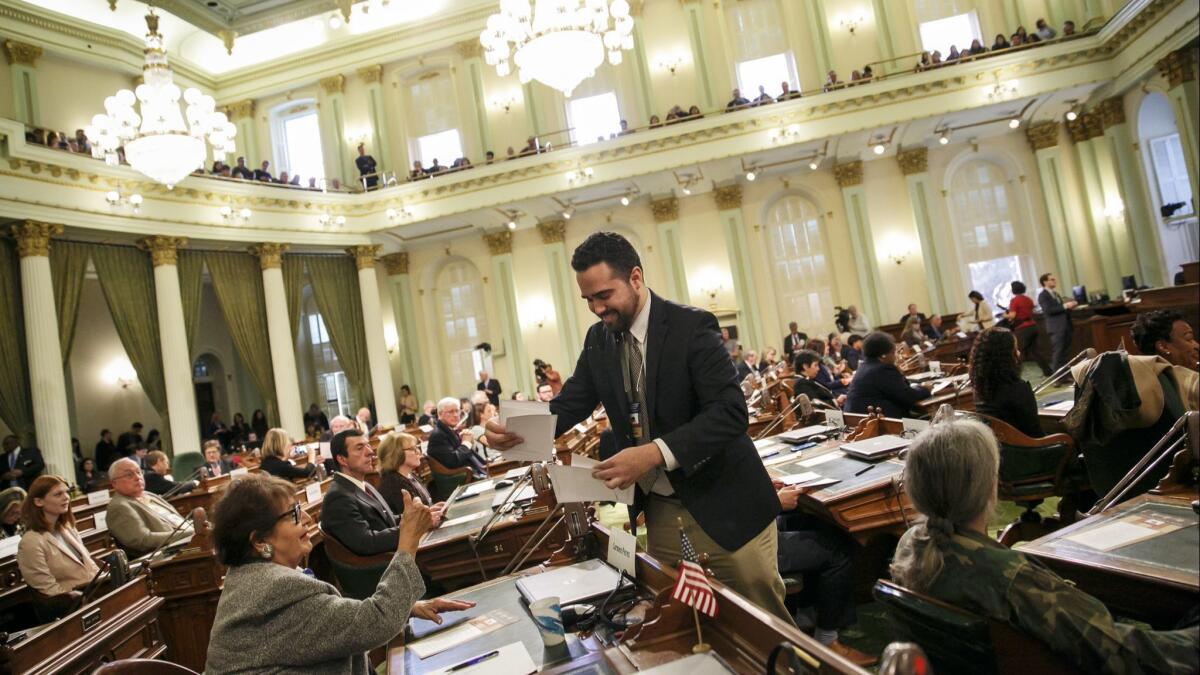No, the electoral college isn’t ‘electoral affirmative action’ for rural states

- Share via
Attacks on the electoral college are nothing new, but there’s no question that it’s been under heavier fire than usual lately. Presidential candidates Elizabeth Warren, Bernie Sanders, Pete Buttigieg and Beto O’Rourke have all said they want to scrap it. Rep. Alexandria Ocasio-Cortez (D-N.Y.) has repeatedly tweeted against it as well.
“Every vote should be = in America, no matter who you are and where you come from,” she said. Ocasio-Cortez went on to argue that the electoral college allows smaller, rural states outsized influence over the presidential election process, claiming it is akin to “electoral affirmative action.”
But how much does the electoral college really advantage smaller states?
It does overrepresent some states and underrepresent others, relative to their share of the population. Yet the skew is slight and did nothing to tip the 2016 presidential election to Donald Trump.
Each state is given electoral college delegates equal to the combined number of its U.S. senators and representatives. Thus, every state — no matter its share of the overall population — is guaranteed at least three electoral college delegates. This means a few states with very sparse populations do get overrepresented.
For instance, Wyoming’s three electoral college delegates account for about one-half of 1% of the 538 electoral college votes. However, the state’s 564,000 residents (as of the last census) are only 0.1 percent of the U.S. population.
Meanwhile, the most populous states are somewhat underrepresented. For instance, the nearly 40 million Californians account for approximately 12% of the U.S. population while their state controls a little over 10% of the electoral college votes.
California and Wyoming, as the most and least populous states, illustrate the biggest gaps between electoral college representation and proportion of the population. In every other case, the differences are much smaller. In every state but California, Texas and New York, a state’s share of electoral college delegates and U.S. population is within one-half of 1% of the population, according to my calculations.
Even in the aggregate, these representation gaps would not have been a determining factor in the last presidential election. Indeed, if we eliminated these gaps, giving smaller states no additional representation — and if each state awarded all of its electoral college votes in winner-take-all fashion — Trump would have won in 2016 by 12 percentage points, my analysis showed.
The reason Trump was able to win the presidency while losing the popular vote has nothing to do with “affirmative action” for rural states. It has everything to do with the way states choose to apportion their delegates.
Every state, with the exception of Nebraska and Maine, awards all of its electoral college delegates to the candidate who wins the plurality of the votes — less than 50% but more than any other candidate — in their state. This is sometimes called a winner-take-all or “first past the post” system.
Under the Constitution, states can apportion their delegates as they please. The reason more states do not adopt systems like Nebraska and Maine — which each award one electoral college vote to the winner of each congressional district while giving two bonus electors to the statewide winner — differs for swing states and safe states. Among those likely to be swing states, awarding the maximum number of electoral college votes to the statewide winner ensures outsized attention from presidential candidates. For reliably safe states winner-take-all elections confer maximum advantage to the candidate favored by the clear majority of the state’s population (and, likely, the state’s elected officials).
More sensible liberal critics of the electoral college focus on this system’s tendency to exaggerate the importance of swing states. As Warren and others have pointed out, presidential candidates rarely visit deep-red or deep-blue states. They focus the majority of their time and money on states such as Ohio and Florida, which have a close partisan balance and a fair number of electoral votes. The importance of each individual voter in these states is greatly magnified because a voter’s odds of determining the statewide winner (and, in turn, the winner of all the state’s electoral college votes) is comparatively high.
But every state — whether largely rural or densely populated, coastal or interior, ethnically diverse or homogeneous — has a chance to become a swing state. As populations and attitudes shift, so does the presidential battleground map. Over the last five presidential elections, 34 of the 50 states have been swing states (i.e. won by single digits) at least once.
If the U.S. were to abandon the electoral college in favor of a national popular vote, the same few cities would be the focus of the battle for the White House every cycle. Given that they have limited time and money, presidential candidates of both parties would be foolish to waste their energy anywhere but the most densely populated urban centers. This is where the largest concentration of voters are, so racking up the votes in these areas would be the overwhelming focus of any election.
Under a national popular vote, cities like Los Angeles and New York, which already dominate our country’s economic and cultural life, would thoroughly and perpetually dominate electoral politics as well. Avoiding such an outcome does not translate to affirmative action for rural areas.
It is a nod to a historical reality: When large swaths of a vast country feel they have been forgotten, dark days are likely to be on the horizon.
John W. York is a policy analyst in the Heritage Foundation’s Simon Center for Principles and Politics.
More to Read
A cure for the common opinion
Get thought-provoking perspectives with our weekly newsletter.
You may occasionally receive promotional content from the Los Angeles Times.









